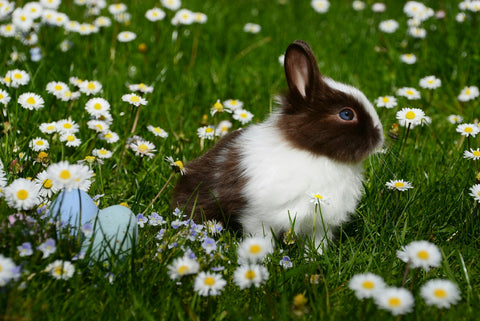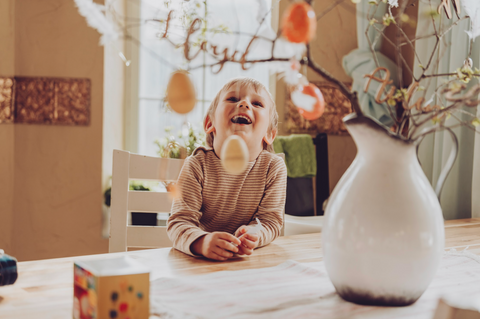We are on Trustpilot
We are rated Excellent, read what our customers are saying

🌼 Eggs, Witches & Feasts: How Scandinavia Celebrates Easter
Spring is in the air, the days are getting longer, and Scandinavia is gearing up for one of its coziest and quirkiest holidays—Easter!
While Easter has Christian origins, in Sweden, Norway, and Denmark, it’s just as much a secular holiday filled with food, folklore, and family traditions. From Easter witches in Sweden to crime novels in Norway and letter puzzles in Denmark, each country brings its own special twist to the holiday.
So, what makes Scandinavian Easter so unique? Let’s dive into the fun, the feasts, and the fascinating traditions that make this holiday special.

In Scandinavia, Easter is one of the biggest holidays of the year, but it doesn’t quite reach the level of Christmas or Midsummer in Sweden. Instead of grand religious observances, it’s more about relaxing, feasting, and celebrating the arrival of spring after a long, dark winter.
One of the biggest appeals of Easter in Scandinavia is that it’s a long weekend, offering many people time off work to enjoy the holiday. In Norway and Denmark, Maundy Thursday is a public holiday, giving people an extra day to unwind. In Sweden, Maundy Thursday is a regular workday, but Good Friday, Easter Sunday, and Easter Monday are all public holidays, creating a cozy four-day weekend.
Unlike Christmas, which is centered around home and tradition, Easter is a mix of family time and travel. Many Swedes and Danes head to their summer cottages for the first time in the year, eager to escape the city and enjoy long walks, outdoor meals, and a sense of renewal. Meanwhile, Norwegians take it to another level—flocking to their ski cabins in the mountains for a week of skiing, reading crime novels, and indulging in Easter treats.
Overall, Scandinavian Easter is about comfort, connection, and good food, with each country adding its own unique flavor to the celebration.

Swedish Easter (Påsk) is a blend of old folklore, delicious food, and vibrant decorations. Some of the traditions might surprise you—especially the Easter witches!
One of Sweden’s most quirky and beloved Easter traditions is the påskkärringar—the Easter witches. 🧙♀️
On Maundy Thursday (Skärtorsdag), Swedish children dress up as friendly witches, wearing colorful skirts, aprons, and scarves tied under their chins, with painted freckles on their cheeks. They go door to door in their neighborhoods, handing out handmade Easter cards in exchange for candy—much like Halloween, but in spring!
This tradition stems from ancient Swedish folklore, which claimed that on Maundy Thursday—the day of Jesus' Last Supper—witches flew to Blåkulla, a mythical mountain where they met the Devil for a wild feast.
Centuries ago, people took these stories very seriously. During Sweden’s witch trials (1668–1676), dozens of women were accused of flying to Blåkulla and were executed. The fear of witches was so real that Swedes would light bonfires and shoot rifles into the air on Easter Eve to scare them away.
Over time, the fear turned into fun, and by the 1800s, children started dressing up as playful Easter witches instead. Today, it’s a beloved Swedish tradition, especially in the countryside.
If you’re in Sweden during Easter, stock up on candy—because little witches might knock on your door!

Another classic Swedish Easter decoration is påskris—bundles of birch twigs decorated with colorful feathers, ribbons, and small ornaments. These festive branches brighten up homes, storefronts, and even city streets.
This tradition dates back to the 1600s, when people would take birch twigs and lightly whip each other on Good Friday as a reminder of Christ’s suffering. Thankfully, the whipping part disappeared over time, and by the 1800s, Swedes began decorating the twigs instead.
Today, påskris is a must-have in every Swedish home, symbolizing the arrival of spring. Some families even hang little Easter eggs from the branches for an extra festive touch.

Forget small chocolate eggs—Swedes go all out with giant, beautifully decorated cardboard eggs filled with candy! 🥚🍬
Swedish Easter eggs (påskägg) are stuffed with an assortment of sweets, including:
🍫 Marabou chocolate – A Swedish favorite
🍬 Daim bars – Crunchy caramel and chocolate goodness
😝 Saltlakrits (salty licorice) – A love-it-or-hate-it treat!
Swedes take their Easter candy seriously—in fact, Easter is one of the biggest candy-eating holidays in Sweden, second only to Christmas. The average Swede eats over 1kg of candy during Easter! 😲
No Swedish holiday is complete without a feast, and Easter is no exception. The påskbord (Easter buffet) is a springtime version of the famous Swedish smörgåsbord, featuring:
🥚 Hard-boiled eggs – Often topped with shrimp, mayo, or dill
🐟 Pickled herring (sill) – A must-have in multiple flavors
🐑 Lamb roast – Becoming more popular as an Easter main dish
🥔 Janssons frestelse – A creamy potato and anchovy casserole
🥧 Västerbotten cheese pie – A beloved Easter dish
To drink, Swedes love Påskmust, a spiced malt soda that outsells Coca-Cola during Easter! 🥤 While some argue it’s just the Christmas soda “Julmust” in a different bottle, Swedes will passionately debate the difference. 😆
👉 Swedish Easter is all about food, fun, and family traditions that bring warmth and joy after the long winter.

Norwegian Easter is all about coziness, nature, and a surprising obsession with crime novels!
Believe it or not, Norway has a national tradition of reading crime novels at Easter! Bookstores release special “Easter thrillers,” TV stations air detective dramas, and even milk cartons feature crime stories.
This tradition started in 1923, when a newspaper ad for a crime novel looked so realistic that people thought it was a real crime report. Ever since, Norwegians have associated murder mysteries with Easter. 🕵️♂️🔎
While Swedes stay home feasting, many Norwegians head to their cabins (hytter) in the mountains for a week of skiing, sledding, and soaking up the last of the snow.
Nothing says Norwegian Easter like:
🎿 A ski trip with family
🍫 A Kvikk Lunsj bar (Norway’s Kit-Kat)
🍊 An orange (Norwegians eat millions of them at Easter!)

Danish Easter is filled with cozy gatherings, fun games, and plenty of food and drinks!
One of Denmark’s cutest traditions is gækkebrev—decorative paper-cut letters sent anonymously. The sender writes a poem and signs it with dots instead of their name.
If the recipient guesses who sent it, they win an Easter egg! If they can’t guess, they owe the sender an egg! 🥚
Danish families gather for a long, delicious Easter lunch (påskefrokost), featuring:
🥪 Smørrebrød – Open-faced sandwiches with pickled herring, liver pâté, and salmon
🥚 Hard-boiled eggs – Served with mustard and dill
🐑 Lamb roast – A traditional Easter dinner
🍺 Påskebryg (Easter beer) – A strong seasonal brew
🥃 Snaps (Aquavit) – Because no Danish feast is complete without it!
Danish Easter lunches often turn into lively drinking parties—expect plenty of toasts and laughter!
Whether you’re dressing up as an Easter witch in Sweden, escaping to a cozy cabin in Norway, or sending secret gækkebreve letters in Denmark, one thing is certain—Scandinavian Easter is a time for food, fun, and quirky traditions! From colorful feathers on birch twigs to feasts of pickled herring and lamb, the holiday is a perfect mix of old folklore and modern celebrations.
